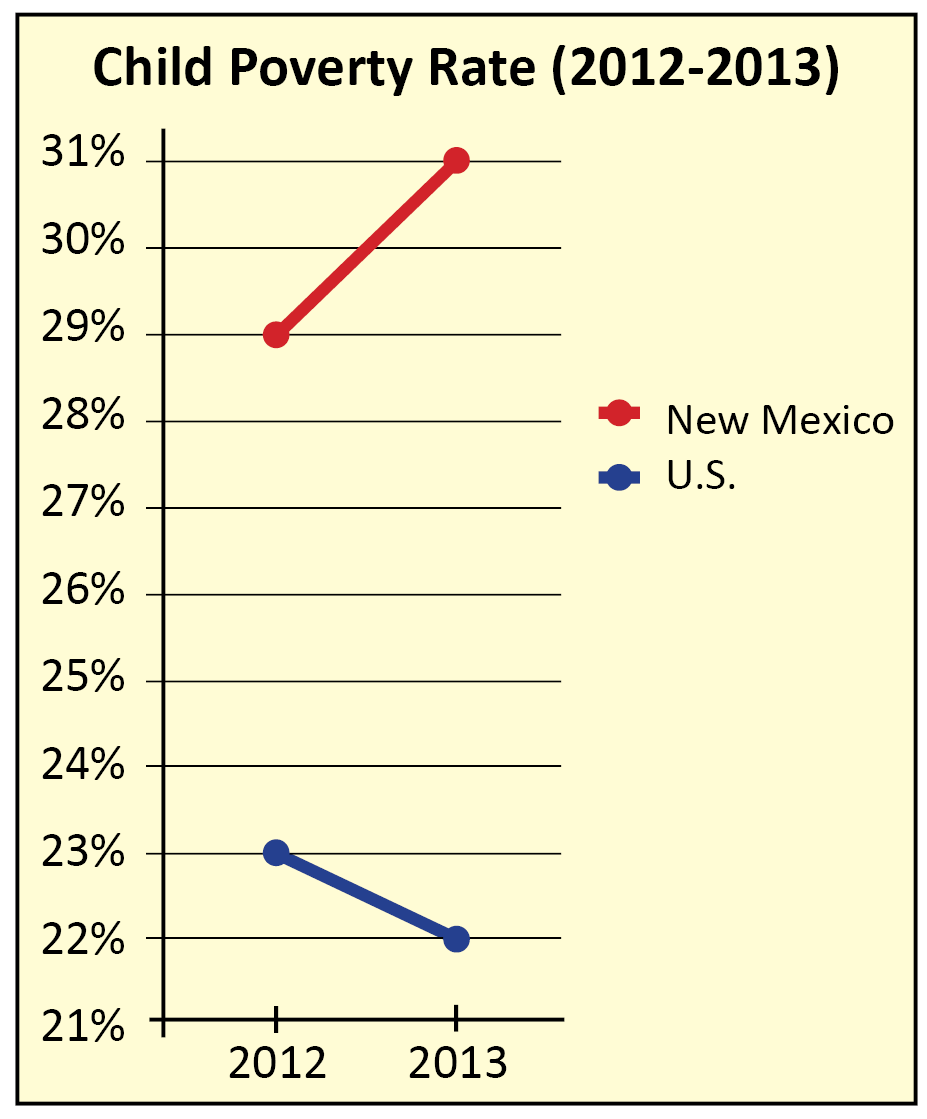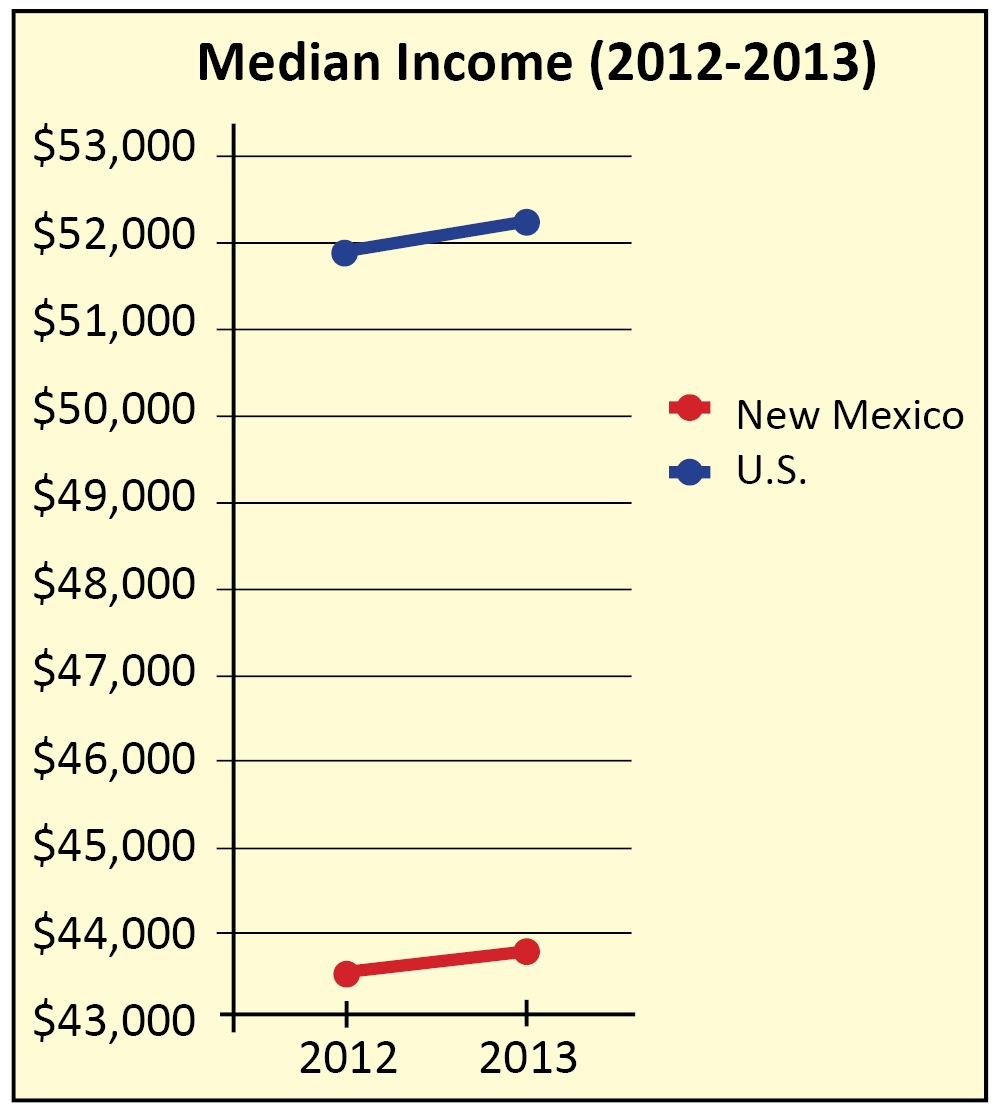by Amber Wallin
October 8, 2014
The recent Census data releases on poverty delivered some reasonably good news for the nation, but bad news for New Mexico. The Census gives us an annual look at how families are faring across the nation. While the rest of the nation is recovering—albeit very slowly—from the recession, New Mexico is still stuck in economic limbo, and a lot of our families are still struggling. This is important because in order for New Mexico’s economy to thrive, its people have to have the opportunities to do so as well; and New Mexico’s economy can’t get better when so many of its families are barely getting by. But it doesn’t have to be this way—there are common sense solutions that can address poverty and help make families and the economy stronger. Before looking at some of the solutions though, let’s take a quick look at what the Census data shows.

Census data also showed that the U.S. poverty rate among Hispanics fell, while at the same time, New Mexico’s Hispanic poverty rate grew. This means 15,000 more Hispanics dropped below the poverty line in 2013.
The data told the same story about kids living in poverty. Nationwide, the percent of kids in poverty improved, while in New Mexico, the already terrible rate of child poverty got worse. Only one other state has a worse childhood poverty rate.
Like the rest of the nation, median income in New Mexico remained relatively flat with both the state and the nation seeing less than $500 in median income growth. 
The slight improvements in nationwide statistics reflect wage gains for low-income earners (minimum wages increased in 10 states during the reporting period) and improved job markets in most areas. In other words, fewer people are in poverty because workers on the edge of poverty are making more money and because most areas have more jobs to offer. It is not surprising then that while the rest of the nation creeps forward towards economic recovery, New Mexico continues to lag behind. The state hasn’t increased its minimum wage since 2009 and has lost more than 45,000 jobs since the recession hit. And despite a bevy of big corporate tax cuts (paid for by regular New Mexicans) that slashed taxes for big businesses, new jobs just aren’t materializing.
To compound our inability to recover from the recession, New Mexico has one of the highest rates of income inequality. Only five other states and the District of Columbia are worse. According to the Census, income inequality nationwide increased in 2013 and is at near-record levels. 
Things are bad, and they are obviously not getting better. It is time for action, and policy makers in our state have no excuses for not pursuing some obvious and already-proven solutions. Other states are increasing their minimum wages—it is time for New Mexico to do the same. As shown in a recent report by NM Voices, increasing the minimum wage by one dollar, to just $8.50 per hour, would benefit 540,000 New Mexicans and generate approximately $50 million in wages for the lowest wage earners. Because minimum wage workers tend to spend much of their money quickly and locally, this money would go right back into local economies.
The same goes for tax benefits for low- and middle-income New Mexicans. Policy makers should consider bolstering these tax policies—like the Working Families Tax Credit (our state’s version of the Earned Income Tax Credit) and the Low Income Comprehensive Tax Rebate—that combat inequality and help poor families meet their most basic needs. In fact, according to a recent report by the Center on Budget and Policy Priorities, a particularly effective way states can help working families move and stay out of poverty is to increase their minimum wage while at the same time strengthening their EITC.
As far as long-term solutions go, we know that investments in early childhood have big payouts for kids, parents, communities, and state economies. We know that kids in poverty show worse health and educational outcomes and that these outcomes have negative, lasting effects on kids and their communities. We’ve heard policy makers, advocates, and others say again and again how important the early years are. And we have many evidence-based and proven policy solutions already in place—including home visiting, pre-kindergarten, high-quality child care, and child care assistance—that can bolster outcomes for the kids and families who receive them, and improve the quality of life for all. It is time to fully fund early childhood care and education.
As recent Census data have shown, New Mexico is in the throes of a crisis. Our whole state is suffering from a stagnant economy. There has never been a greater need for investments in New Mexico’s greatest resource—our people!
Amber Wallin, MPA, is a Research and Policy Analyst for NM Voices for Children.
